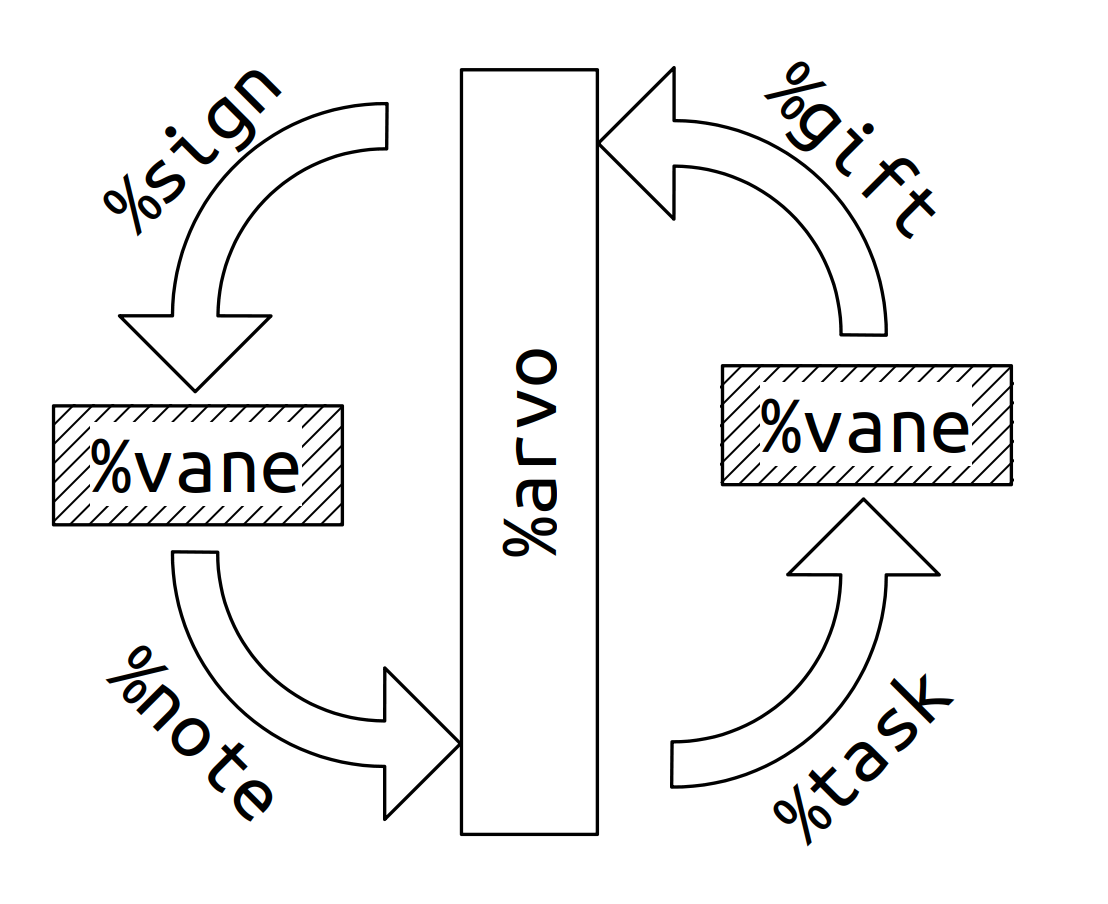martian-computing
CS 498MC Martian Computing at the University of Illinois at Urbana–Champaign
Arvo II

Learning Objectives
- Describe the Arvo event handler, cards, and ducts.
The Core Arvo
The Event Handler
:: arvo: structural interface core
++ arvo
|%
++ come |= [@ @ @ pram vise pone]
(come:soul +<)
++ load |= [@ @ @ pram vase pane]
(load:soul +<)
++ peek |= *
=/ rob (^peek ;;([@da path] +<))
?~ rob ~
?~ u.rob ~
[~ u.u.rob]
++ poke |= *
=> .(+< ;;([now=@da ovo=ovum] +<))
(poke:soul now ovo)
++ wish |=(* (^wish ;;(@ta +<)))
--
++pokeis the only arm which can transition Arvo from one state to another. It is a typed transactional message.++peekprovides a globally referentialscrynamespace++wishparses a core with%zuse++loadupgrades the kernel++comeis used with a new kernel
Altogether, Arvo is remarkably straightforward (as an event handler should be) and has the surprising ability to upgrade itself in-place.
- Tlon Corporation, “Arvo Tutorial”, section “The State”
The State
The Arvo state is represented as a structure:
=/ pit=vase !>(..is) ::
=/ vil=vile (viol p.pit) :: cached reflexives
=| $: lac=_& :: laconic bit
eny=@ :: entropy
our=ship :: identity
bud=vase :: %zuse
vanes=(list [label=@tas =vane]) :: modules
== ::
++ card {p/@tas q/*} :: typeless card
++ ovum {p/wire q/card} :: Arvo event
++ wire path :: event cause
Arvo is a core with these six arms. To use these arms, we hardcode the axis of the formula (11, 4, 86, etc) into the C code that calls Arvo, because otherwise we’d need type metadata - which we can get, by calling Arvo.
pitrepresents the part of Arvo which only changes in an updatevilis a cache of types which shouldn’t be recompiled regularly due to frequency of use:type,duct,vaselacis the verbosity of the kernelenyis system entropyouris the ship’s identitybudis the standard libraryvanesis the list of vanes with internal state
One of the most salient system calls is to obtain entropy, or random generated numeric noice. Ultimately, entropy must be drawn from the Unix system via an ovum (see below):
%wack
?> ?=(@ q.q.ovo)
=. eny (shaz (cat 3 eny q.q.ovo))
The flip side of this call may be found in urbit/vere/io/fore.c,
// inject fresh entropy
//
c3_w eny_w[16];
c3_rand(eny_w);
wir = u3nc(c3__arvo, u3_nul);
cad = u3nc(c3__wack, u3i_words(16, eny_w));
u3_auto_plan(car_u, u3_ovum_init(0, u3_blip, wir, cad));
where it is obtained from the system via urbit/vere/pier.c:
/* c3_rand(): fill a 512-bit (16-word) buffer.
*/
void
c3_rand(c3_w* rad_w)
{
ent_getentropy(rad_w, 64) )
}
libentis a cross-platform wrapper aroundgetentropy(2). It exports one symbol,ent_getentropy. Ifgetentropyis available, then it’s just a shim around that. Otherwise, it usesgetrandom(2)(available since kernel 3.17) on Linux, or/dev/urandomon other *nix.
- Tlon Corporation, “Arvo Tutorial”, section “The State”
Ducts

Arvo orchestrates vane activities using cards, but a card isn’t sent naked. It is accompanied by a duct, or list of causal events as a (list wire).
Arvo mandates that each vane maintain a queue of causal events. Vanes coordinate their duct/call stacks as queues (++to arm, common name qeu).
The Arvo causal stack is called a
duct. This is represented simply as alistofpaths, where eachpathrepresents a step in the causal chain. The first element in thepathis the first letter of whichever vane handled that step in the computation, or the empty span for Unix.This is a call stack, with a crucial feature: the stack is a first-class citizen. You can respond over a
ductzero, one, or many times. You can saveducts for later use.
An incoming card is placed in a vane’s queue, with the provenance indicated in case errors or gifts need to be sent back along the call path.
There are four kinds of cards:
In other words, there are only four ways of seeing a move:
- as a request seen by the caller, which is a
note;- that same request as seen by the callee, a
task;- the response to that first request as seen by the callee, a
gift;- the response to the first request as seen by the caller, a
sign.

The system also frequently deals in the ovum type,
+$ ovum (pair wire curd)
which is a “card with a cause,” or a way of passing steps and actions into Arvo that is also compatible with %unix cards.
For input events, this is the module that caused the event; for output actions, it’s the module that performs the action.
- Reading: Tlon Corporation, “Vere API Overview by Prefix”, section “u3v: the Arvo kernel”
